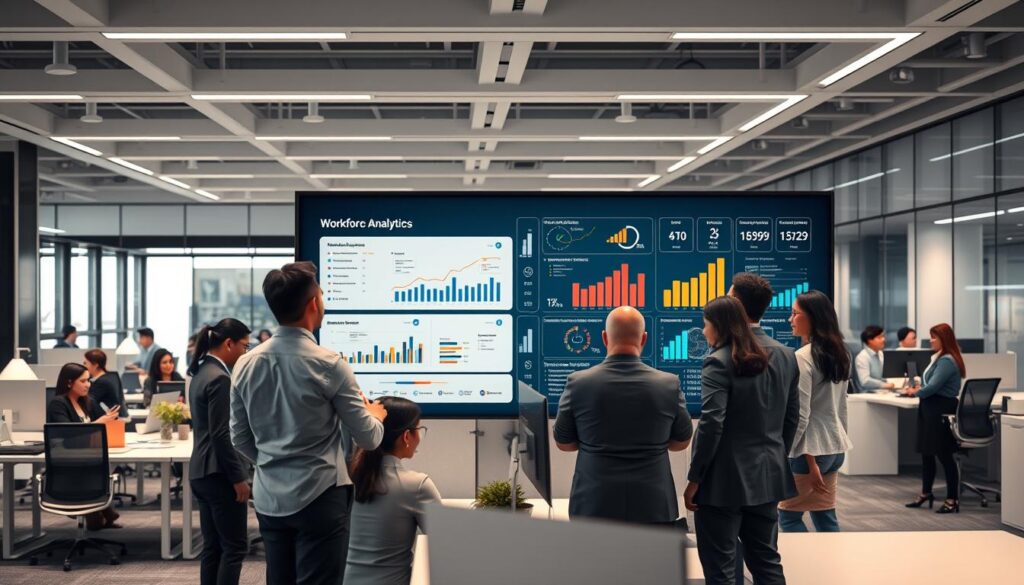Are you using predictive analytics in your workforce planning? Today’s job market is changing fast. It’s key to use past data to predict future workforce needs. Predictive HR analytics helps match your human resources with your goals, making your team more flexible and ready to adapt.
In places like Southeast Asia, companies are using AI to improve hiring and managing talent. By adopting these new tools, businesses can make smarter hiring choices. This helps them stay ahead in a world where industries are always shifting. Learn how predictive analytics can change how you manage your workforce with examples and insights.
Key Takeaways
- Predictive analytics enhances the alignment of HR capabilities with organizational goals.
- Implementing predictive HR analytics can significantly improve recruitment strategies.
- AI workforce planning tools facilitate a more adaptive workforce.
- Data-driven decisions result in better talent management practices.
- Understanding workforce analytics & planning is essential in fast-evolving markets.
Understanding Predictive Analytics in Workforce Planning
Predictive analytics is a method for analyzing data to predict future needs. It helps organizations plan their workforce better. By looking at past and current data, businesses can understand many aspects of managing employees.
Definition and Importance
Predictive analytics is about finding trends in data. It’s key for planning the workforce. It helps forecast needs, understand turnover, and check performance. Companies using it make better decisions, keeping employees happy and on board.
How Data Drives Decisions
Data is crucial for making plans. It helps companies know what they need in their workforce. Predictive analytics helps avoid risks and use resources well. This leads to a more productive and engaged team, showing why data is important in planning.

Benefits of Predictive Analytics in HR
Predictive analytics changes the game for HR by turning data into useful insights. It helps companies forecast their workforce needs. This way, they can plan ahead and meet their business goals. It also helps avoid talent shortages and use resources wisely.
Forecasting Future Workforce Needs
Getting talent management right is key for any business. Predictive analytics helps HR spot trends in hiring and turnover. This way, companies can keep their teams balanced with the right number of people.
Enhancing Talent Acquisition Strategies
Using predictive analytics in hiring makes a big difference. HR can look at past data to find what makes a hire successful. This helps them focus on finding the best candidates for each role.
Optimizing Training and Development Programs
Predictive analytics is also great for training. It helps identify skill gaps and prepare employees for new roles. This not only boosts skills but also keeps employees happy and loyal, helping the company grow.

| Aspect | Benefits of Predictive Analytics |
|---|---|
| Workforce Needs Forecasting | Ensures efficient staffing, preventing talent shortages |
| Talent Acquisition Analytics | Refines recruitment strategies, enhancing candidate quality |
| Training Development Optimization | Addresses skill gaps, preparing employees for future challenges |
The Role of AI in AI Workforce Planning
Artificial Intelligence has changed how we plan our workforce, mainly in the AI job market. Companies use AI to look at big data, making better hiring choices. With more jobs needing AI skills, HR faces new challenges to find the right people.
Trends in AI-driven Job Markets
Today, we see more jobs in AI and machine learning everywhere. Southeast Asia is leading in this area, creating more jobs. Companies are now using data to make smarter decisions, with 94% of leaders saying AI helps with data management.
So, companies need to update their plans for AI workers to stay ahead. This is key to using new trends to their advantage.
Impact of AI on Recruitment Practices
AI is making hiring smarter. It helps find the best candidates for each job. This makes hiring faster and more efficient.
Workforce Analytics & Planning: A Comprehensive Approach
Using vast data sets, organizations can gain insights that give them a competitive edge. This approach helps businesses manage talent better. It also lets them align their workforce with their business goals through predictive analytics.
Leveraging Data for Competitive Advantage
Looking at performance metrics, turnover rates, and employee satisfaction is key. These data points help spot areas for improvement. This way, companies can plan ahead and stay competitive.
Integrating Predictive Analytics into HR Processes
HR processes benefit from analyzing data like recruitment numbers, training success, and feedback. This helps create strategies that engage employees. With real-time data, HR can predict staffing needs and adjust plans as needed.

Case Studies: Predictive Analytics Success Stories in Asia
Many companies in Asia have used predictive analytics to improve their workforce strategies. These stories show how top Asian companies use data to match their human resources with changing market trends. They have seen big improvements in hiring and keeping employees.
Leading Companies Leveraging Analytics
Some big names are leading the way in predictive analytics. For instance, big tech companies use complex models to find skill gaps and improve hiring. They also make employees happier. Telecommunications companies are also big users, using data to guess what customers want and adjust their teams.
Lessons from Industry Leaders in Southeast Asia
Lessons from Southeast Asia highlight the importance of customizing analytics. Companies learn about employee and market trends, helping them improve. This ability to adapt shows the strength of data in today’s business world.

Challenges in Implementing Predictive Analytics
Using predictive analytics offers big benefits but also faces some big challenges. Making sure data is good and dealing with resistance in the workplace are key ones. Knowing how to tackle these issues can help make analytics work well in planning the workforce.
Overcoming Data Quality Issues
Data problems often come from bad or missing information. It’s hard to get all the data needed for good predictions. If the data is not right, predictions won’t be good, which hurts the value of analytics.
To fix this, regular checks on data and making sure it’s accurate are key. Companies should also work together to make sure data is reliable. This helps make sure the data is good to use.
Navigating Cultural Resistance
Getting people to accept predictive analytics can be tough. Some might not trust it or feel it’s taking over their job. To get past this, it’s important to talk openly and involve everyone in the process.
Showing how predictive models help and teaching people about data can make a big difference. This way, companies can make a place where analytics is welcomed and used well.
| Challenges in Implementation | Data Quality Issues | Cultural Resistance |
|---|---|---|
| Common Sources | Incomplete datasets, inaccurate records | Employee skepticism, lack of buy-in |
| Strategies for Resolution | Regular data audits, collaboration among teams | Training programs, open communication |
| Impact on Analytics | Undermined predictive efficacy | Delayed or failed adoption |
Best Practices for Effective Predictive Workforce Analytics
For organizations to improve their workforce planning, using predictive analytics is key. Building a data-driven culture is a big step. It makes everyone see the importance of analytics.
This change helps use data insights in daily work. It leads to better decisions and a more effective team.
Building a Data-Driven Culture
Creating a data-driven culture needs strong leadership and a focus on analytics. It’s important to share data strategies openly. This builds trust among employees.
Organizations can hold workshops to show how predictive analytics helps. This helps team members see the value of data in their work.
Investing in Training and Tools
HR teams need training to use analytics well. Training should cover how to interpret data and use tools. Giving teams access to advanced tools helps them work better.
With these steps, organizations can make predictive analytics work well. This leads to better workforce outcomes.
Future Trends in Workforce Analytics
Workforce analytics is changing how companies find and train workers. As markets shift, new tools and strategies will become key. This is true for businesses in the Philippines and around the world.
The Rise of Smart Recruitment Tools
Smart recruitment tools are making hiring better. They use AI and machine learning to pick the best candidates. This makes hiring faster and more accurate.
These tools look at real-time data and predictions. They help companies find the right people for their needs. This makes hiring better for everyone and helps companies succeed in the long run.
Adaptive Learning and Continuous Improvement
Adaptive learning is a big part of future workforce analytics. It means learning new skills as the job changes. Companies are creating training that keeps up with the latest needs.
This training helps employees stay ready for new challenges. It makes a workforce that can adapt quickly. This gives companies an edge in a fast-changing world.
Conclusion
As we wrap up our talk on predictive analytics, it’s clear that these tools are key for any business. They help in making better decisions by using data. This way, companies can match their human resources with their big goals.
This approach boosts efficiency and improves how they find and manage talent. It’s a big step towards success.
Many Asian companies have shown how predictive analytics can make a difference. They use it to create a more flexible and effective team. This helps them stay ahead in a changing market.
By choosing to use predictive analytics, companies show they are looking to the future. They create a culture that values data. This lets them lead, not just follow, in their industry.

